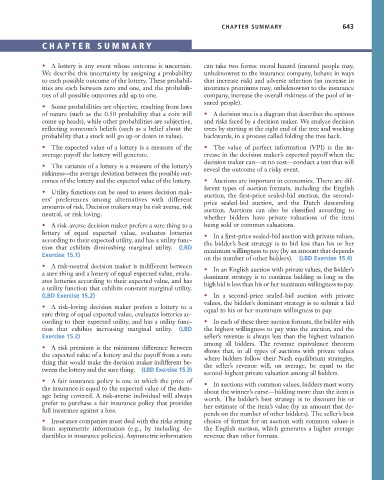Page 669 - Microeconomics, Fourth Edition
P. 669
c15riskandinformation.qxd 8/16/10 11:10 AM Page 643
CHAPTER SUMMARY 643
CHAPTER SUMMAR Y
• A lottery is any event whose outcome is uncertain. can take two forms: moral hazard (insured people may,
We describe this uncertainty by assigning a probability unbeknownst to the insurance company, behave in ways
to each possible outcome of the lottery. These probabil- that increase risk) and adverse selection (an increase in
ities are each between zero and one, and the probabili- insurance premiums may, unbeknownst to the insurance
ties of all possible outcomes add up to one. company, increase the overall riskiness of the pool of in-
sured people).
• Some probabilities are objective, resulting from laws
of nature (such as the 0.50 probability that a coin will • A decision tree is a diagram that describes the options
come up heads), while other probabilities are subjective, and risks faced by a decision maker. We analyze decision
reflecting someone’s beliefs (such as a belief about the trees by starting at the right end of the tree and working
probability that a stock will go up or down in value). backwards, in a process called folding the tree back.
• The expected value of a lottery is a measure of the • The value of perfect information (VPI) is the in-
average payoff the lottery will generate. crease in the decision maker’s expected payoff when the
decision maker can—at no cost—conduct a test that will
• The variance of a lottery is a measure of the lottery’s reveal the outcome of a risky event.
riskiness—the average deviation between the possible out-
comes of the lottery and the expected value of the lottery. • Auctions are important in economics. There are dif-
ferent types of auction formats, including the English
• Utility functions can be used to assess decision mak- auction, the first-price sealed-bid auction, the second-
ers’ preferences among alternatives with different price sealed-bid auction, and the Dutch descending
amounts of risk. Decision makers may be risk averse, risk auction. Auctions can also be classified according to
neutral, or risk loving.
whether bidders have private valuations of the item
• A risk-averse decision maker prefers a sure thing to a being sold or common valuations.
lottery of equal expected value, evaluates lotteries • In a first-price sealed-bid auction with private values,
according to their expected utility, and has a utility func- the bidder’s best strategy is to bid less than his or her
tion that exhibits diminishing marginal utility. (LBD maximum willingness to pay (by an amount that depends
Exercise 15.1)
on the number of other bidders). (LBD Exercise 15.4)
• A risk-neutral decision maker is indifferent between • In an English auction with private values, the bidder’s
a sure thing and a lottery of equal expected value, evalu- dominant strategy is to continue bidding as long as the
ates lotteries according to their expected value, and has high bid is less than his or her maximum willingness to pay.
a utility function that exhibits constant marginal utility.
(LBD Exercise 15.2) • In a second-price sealed-bid auction with private
values, the bidder’s dominant strategy is to submit a bid
• A risk-loving decision maker prefers a lottery to a equal to his or her maximum willingness to pay.
sure thing of equal expected value, evaluates lotteries ac-
cording to their expected utility, and has a utility func- • In each of these three auction formats, the bidder with
tion that exhibits increasing marginal utility. (LBD the highest willingness to pay wins the auction, and the
Exercise 15.2) seller’s revenue is always less than the highest valuation
among all bidders. The revenue equivalence theorem
• A risk premium is the minimum difference between shows that, in all types of auctions with private values
the expected value of a lottery and the payoff from a sure where bidders follow their Nash equilibrium strategies,
thing that would make the decision maker indifferent be- the seller’s revenue will, on average, be equal to the
tween the lottery and the sure thing. (LBD Exercise 15.3)
second-highest private valuation among all bidders.
• A fair insurance policy is one in which the price of • In auctions with common values, bidders must worry
the insurance is equal to the expected value of the dam- about the winner’s curse—bidding more than the item is
age being covered. A risk-averse individual will always worth. The bidder’s best strategy is to discount his or
prefer to purchase a fair insurance policy that provides her estimate of the item’s value (by an amount that de-
full insurance against a loss.
pends on the number of other bidders). The seller’s best
• Insurance companies must deal with the risks arising choice of format for an auction with common values is
from asymmetric information (e.g., by including de- the English auction, which generates a higher average
ductibles in insurance policies). Asymmetric information revenue than other formats.

